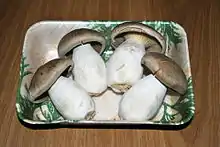Shimeji
Shimeji (Japanese: シメジ, 占地 or 湿地) is a group of edible mushrooms native to East Asia, but also found in northern Europe.[1] Hon-shimeji (Lyophyllum shimeji) is a mycorrhizal fungus and difficult to cultivate. Other species are saprotrophs, and buna-shimeji (Hypsizygus tessulatus) is now widely cultivated. Shimeji is rich in umami-tasting compounds such as guanylic acid, glutamic acid, and aspartic acid.[2]



Species
Several species are sold as shimeji mushrooms. All are saprotrophic except Lyophyllum shimeji.
Mycorrhizal
- Hon-shimeji (ホンシメジ), Lyophyllum shimeji
Saprotrophic
- Buna-shimeji (ブナシメジ, lit. beech shimeji), Hypsizygus tessulatus, also known in English as the brown beech or brown clamshell mushroom.
- Hypsizygus marmoreus is a synonym of Hypsizygus tessulatus. Cultivation of Buna-shimeji was first patented by Takara Shuzo Co., Ltd. in 1972 as hon-shimeji and the production started in 1973 in Japan.[8] Now, several breeds are widely cultivated and sold fresh in markets.
- Bunapi-shimeji (ブナピー), known in English as the white beech or white clamshell mushroom.
- Hatake-shimeji (ハタケシメジ), Lyophyllum decastes.
- Shirotamogidake (シロタモギダケ), Hypsizygus ulmarius.
- These two species had been also sold as hon-shimeji.
- Velvet pioppino (alias velvet pioppini, black poplar mushroom, Chinese: 茶樹菇/茶树菇), Agrocybe aegerita.
Shimeji health benefits
Shimeji mushrooms contain minerals like potassium and phosphorus, magnesium, zinc, and copper. Shimeji mushrooms lower the cholesterol level of the body.[11] This mushroom is rich in glycoprotein (HM-3A), marmorin, beta-(1-3)-glucan, hypsiziprenol, and hypsin therefore is a potential natural anticancer agent.[12][13] Shimeji mushrooms contain angiotensin I-converting enzyme (ACE) inhibitor which is an oligopeptide that may be helpful in lowering blood pressure and reducing the risk of stroke in persons having hypertension.[14] Also rich in polysaccharides, phenolic compounds, and flavonoids. Therefore, inhibits inflammatory cytokines and oxidative stress and protects from lung failure.[15] These compounds also help in reducing oxidative stress-mediated disease through radical scavenging activity hence these mushrooms are antioxidants also.[16]
Cooking
Shimeji should always be cooked: it is not a good mushroom to serve raw due to a somewhat bitter taste, but the bitterness disappears completely upon cooking. The cooked mushroom has a pleasant, firm, slightly crunchy texture and a slightly nutty flavor. Cooking also makes this mushroom easier to digest. It works well in stir-fried foods like stir-fried vegetables, as well as with wild game or seafood.[17] Also, it can be used in soups, stews, and in sauces. When cooked alone, Shimeji mushrooms can be sautéed whole, including the stem or stalk (only the very end cut off), using a higher temperature or they can be slow roasted at a low temperature with a small amount of butter or cooking oil. Shimeji is used in soups, nabe and takikomi gohan.
See also
References
- Hon Shimeji located in Sweden - http://www.spiegel.de/wissenschaft/natur/0,1518,703531,00.html (German) - retrieved June 30, 2010
- Hyoeiオリジナルコラム(なでしこ通信) 日本人はキノコが大好き Archived 2007-12-13 at the Wayback Machine, Hyogo NCC College. (in Japanese)
- METHOD FOR ARTIFICIALLY CULTURING LYOPHYLLUM SHIMEJI, TAKARA AGURI KK, JP2001120059. ARTIFICIAL CULTIVATION METHOD OF LYOPHYLLUM SHIMEJI, TAKARA BIO INC, JP2007143565.
- NEW STRAIN OF LYOPHYLLUM SHIMEJI AND USE OF THE SAME, YAMASA SHOYU KK, JP2006271234. METHOD FOR ARTIFICIALLY CULTURING LYOPHYLLUM SHIMEJI AND CULTURE MEDIUM, Yamasa Shoyu KK, JP2007054044.
- 雪国本しめじ Archived 2007-12-15 at the Wayback Machine, Yukiguni Maitake Co., Ltd. (in Japanese)
- ヤマサほんしめじ Archived 2007-12-24 at the Wayback Machine, Yamasa Corporation. (in Japanese)
- ホンシメジ Lyophyllum shimeji — ホンシメジの新品種開発 — Hon Shimej — New Cultivar Development. Hokuto Corporation. Retrieved 2022-02-05.
- Hypsizigus marmoreus - 長期利用微生物参考データ(食品工業利用微生物) Archived 2005-11-06 at the Wayback Machine, Ministry of Economy, Trade and Industry, Japan. (in Japanese)
- Bunashimeji and Bunapi Archived 2007-12-16 at the Wayback Machine, Hokuto Corporation.
- ホクト白1号菌 (第13294号), Plant Variety Protection, Ministry of Agriculture, Forestry and Fisheries (Japan). (in Japanese)
- Idler, D. R.; Burton, M. P. (January 1976). "The pronephroi as the site of presumptive interrenal cells in the hagfish Myxine glutinosa L". Comparative Biochemistry and Physiology. A, Comparative Physiology. 53 (1): 73–77. doi:10.1016/s0300-9629(76)80014-x. PMID 190.
- Tsai, Pei-Feng; Ma, Chia-Yu (December 2013). "Effect of a glycoprotein from mushroom Hypsizygus marmoreus (Peck) Bigelow on growth and differentiation of human leukemic U937 cells". Food and Chemical Toxicology. 62: 782–785. doi:10.1016/j.fct.2013.10.012. PMID 24140968.
- Ikekawa, T.; Saitoh, H.; Feng, W.; Zhang, H.; Li, L.; Matsuzawa, T. (July 1992). "Antitumor activity of Hypsizigus marmoreus. I. Antitumor activity of extracts and polysaccharides". Chemical & Pharmaceutical Bulletin. 40 (7): 1954–1957. doi:10.1248/cpb.40.1954. PMID 1394718.
- Kang, Min-Gu; Kim, Young-Hun; Bolormaa, Zanabaatar; Kim, Min-Kyung; Seo, Geon-Sik; Lee, Jong-Soo (2013). "Characterization of an antihypertensive angiotensin I-converting enzyme inhibitory peptide from the edible mushroom Hypsizygus marmoreus". BioMed Research International. 2013: 283964. doi:10.1155/2013/283964. PMC 3860087. PMID 24380081.
- Liu, Min; Li, Shangshang; Wang, Xiuxiu; Zhu, Yongfa; Zhang, Jianjun; Liu, Hui; Jia, Le (May 2018). "Characterization, anti-oxidation and anti-inflammation of polysaccharides by Hypsizygus marmoreus against LPS-induced toxicity on lung". International Journal of Biological Macromolecules. 111: 121–128. doi:10.1016/j.ijbiomac.2018.01.010. PMID 29307806.
- Chowdhury, Mohammed Mehadi Hassan; Kubra, Khadizatul; Ahmed, Sheikh Rashel (7 February 2015). "Screening of antimicrobial, antioxidant properties and bioactive compounds of some edible mushrooms cultivated in Bangladesh". Annals of Clinical Microbiology and Antimicrobials. 14: 8. doi:10.1186/s12941-015-0067-3. PMC 4328533. PMID 25858107.
- https://foodthesis.com/shimeji-mushroom-health-benefits-and-side-effects/
External links
- Honshimeji Mushroom, RecipeTips.com. Brown Beech (Buna shimeji), White Beech (Bunapi shimeji), and the Pioppino (Agrocybe aegerita) mushrooms.